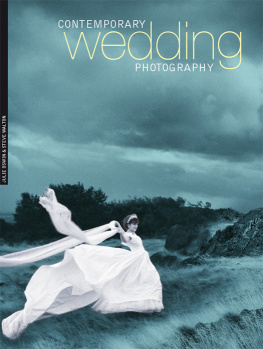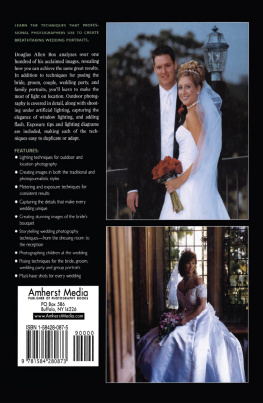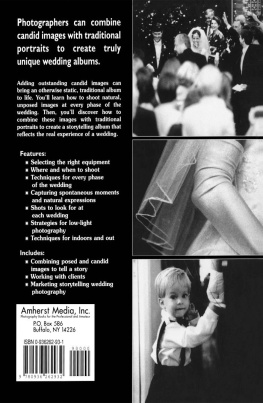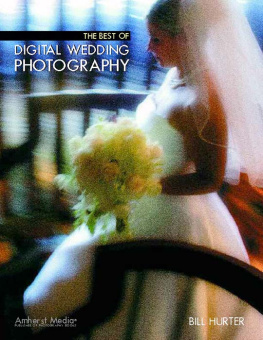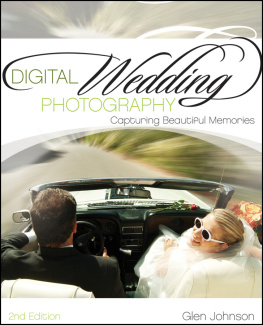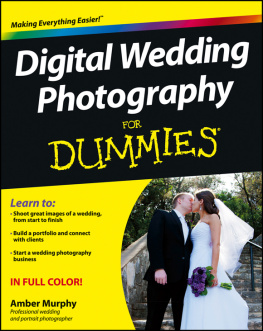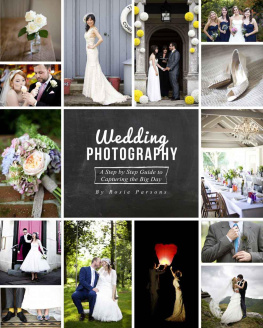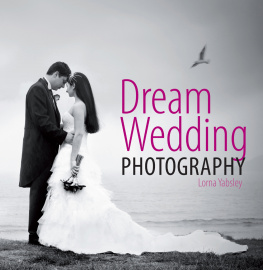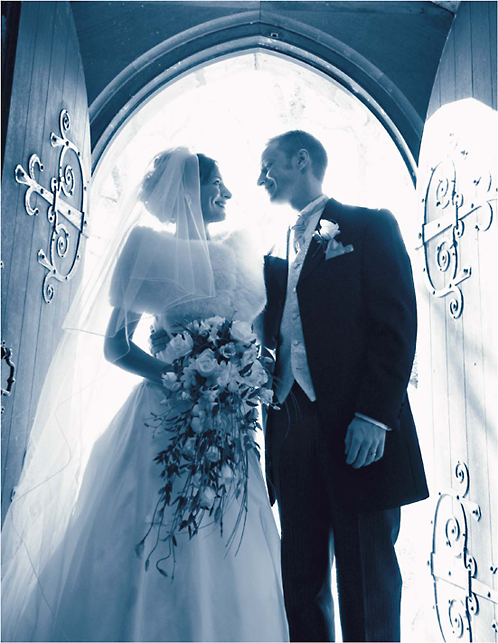CONTEMPORARY wedding PHOTOGRAPHY
A DAVID & CHARLES BOOK
Copyright David & Charles Limited 2006
David & Charles is an F+W Publications Inc. company
4700 East Galbraith Road
Cincinnati, OH 45236
First published in the UK in 2006
Text and illustrations copyright Julie Oswin and Steve Walton 2006
Julie Oswin and Steve Walton have asserted their right to be identifed as authors
of this work in accordance with the Copyright, Designs and Patents Act, 1988.
All rights reserved. No part of this publication may be reproduced, stored
in a retrieval system, or transmitted, in any form or by any means, electronic
or mechanical, by photocopying, recording or otherwise, without prior permission
in writing from the publisher.
A catalogue record for this book is available from the British Library.
ISBN-13: 978-0-7153-2460-8 hardback
ISBN-10: 0-7153-2460-8 hardback
ISBN-13: 978-0-7153-2461-5 paperback (USA only)
ISBN-10: 0-7153-2461-6 paperback (USA only)
Printed in China by SNP Leefung
for David & Charles
Brunel House Newton Abbot Devon
Commissioning Editor Neil Baber
Editor Ame Verso
Copy Editor Cathy Joseph
Art Editor Sarah Underhill
Designer Jodie Lystor
Production Controller Bev Richardson
Visit our website at www.davidandcharles.co.uk
David & Charles books are available from all good bookshops; alternatively
you can contact our Orderline on 0870 9908222 or write to us at FREEPOST
EX2 110, D&C Direct, Newton Abbot, TQ12 4ZZ (no stamp required UK only);
US customers call 800-289-0963 and Canadian customers call 800-840-5220.
CONTEMPORARY wedding PHOTOGRAPHY
JULIE OSWIN & STEVE WALTON
Contents
Introduction
From its earliest days until comparatively recently, wedding photography followed an accepted combination of formal, posed images of the happy couple and interminable family group images. The composition of family groups conformed to rigid standards that remained largely unchanged for decades. The set expressions and regimented poses created by 19th-century wedding photographers were dictated partly by social convention and partly by a technology that required subjects to remain motionless throughout lengthy exposures to avoid image blurring.
This stereotypical social imagery remained the standard until around the 1930s when the rapid development of affordable, basic photographic equipment, changing social habits and expectations, and the evolution of a less regimented approach to social photography gained wider appeal. The major breakthrough in wedding photography must surely have come when some early pioneer realized the lifestyle imagery potential in allowing his sitters to look happy for the camera.
A more sophisticated and affluent society brought higher expectations, aspirations and the confidence of customers to dictate their own personal requirements. The days of the wedding photographer who arrived on the day with just a medium-format camera, a couple of lenses, a flashgun, a tripod and four or five rolls of film are well and truly over. Society no longer requires that kind of approach. This is contemporary wedding photography and the shackles have been cast off.
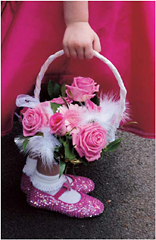
Capturing a moment in time, like this shot of a little bridesmaid holding the flowers, says more than words. A 80200mm lens allows you to get in close without drawing too much attention to yourself. Ensure you have enough space to use this lens. Working quickly and under pressure at a wedding doesnt give you a lot of time to change lenses.
Nikon DSLR, 80200mm lens, 1/250sec at f/2.8

Get in close. The eye contact between the bride and the camera makes this shot, and the expression in her eyes says it all. Expression, expression! That is the key to good wedding photography.
Nikon DSLR, 28-80mm lens, 1/125sec at f/4
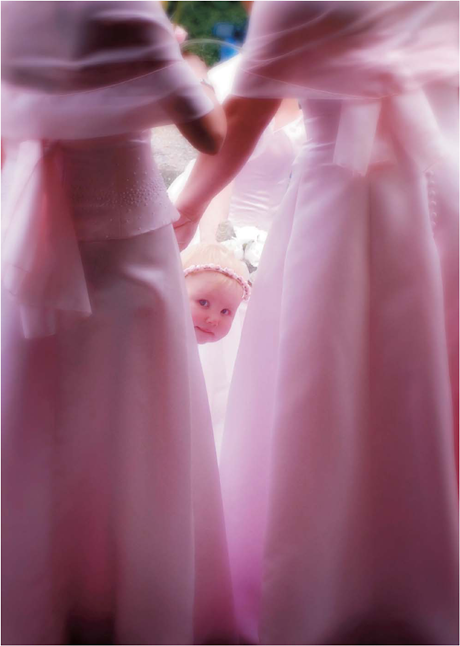
You cant fail with a shot of this nature. It has softness, lovely colour and, of course, the cuteness of the little girl peeping through.
Nikon DSLR, 1755mm lens, 1/60sec at f/2.8

This award-winning photograph was captured between the ceremony and reception. The bride was told to turn slowly towards the sunlight until she was asked to hold the pose. The breeze has just taken her shawl and lifted it slightly, giving movement and shape to the image. The photograph was converted to black and white and blue-toned.
Nikon DSLR, 2880mm lens, 1/250sec at f/8
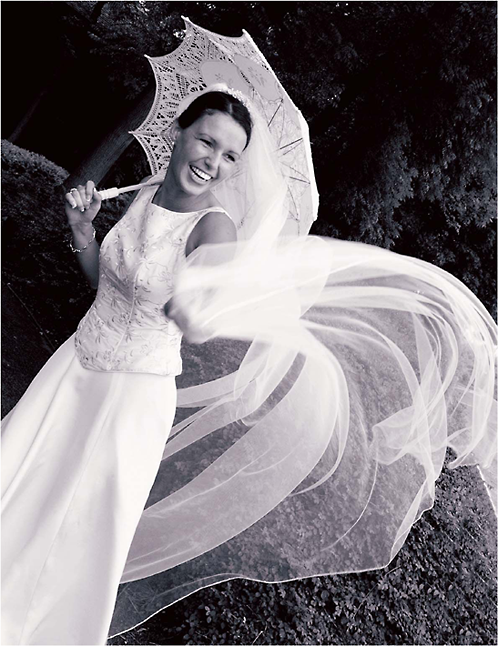
Directing the bride to throw her veil around created movement in this image. Again, the picture works because of the brides expression and the composition.
Nikon DSLR, 2880mm lens, 1/60sec at f/5.6
Digital Innovation
Wedding photography as a developing genre has been accelerated by digital capture, improved image manipulation and album design software packages. As early adopters of digital technology, we have been at the forefront of contemporary wedding photography capture and presentation. In the early days, our conversion to a digital workflow was met with scepticism and doubt by many of our industry colleagues. What has happened in the intervening years is quite predictable. Those sceptics have either now taken the digital route themselves, or they have simply gone out of business. It is a very stark fact of business that if you are unable to provide a product that is in demand, you will cease to trade.
There is no doubt that digital technology has allowed us, and photographers in many other fields, to expand our creative repertoire, both in photography and presentation. Our own early conversion to digital capture and workflow has paid off, but there is no future and nothing to be gained by sitting at the top of the learning curve and gazing down with smug satisfaction as the competition frantically tries to catch up. Those who have both creative ability as photographers and the willingness to gain expertise with evolving technology will take the industry forward. Wedding photography is an exciting place to be at the moment, constrained only by the vision and enthusiasm of its best practitioners. It is a fluid environment and, for professionals, our businesses can grow with it. Interested amateurs can benefit from our techniques to extend their abilities and range.

This is a beautiful image of the bride and her daughter, Libby. The little girl was looking through the window for squirrels. Notice how the brides face has been illuminated by the light reflecting off her dress. Flash would have killed the atmosphere here.

